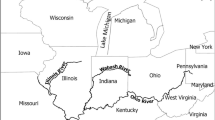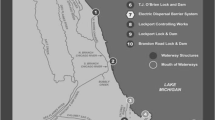Abstract
The Sydenham River in southwestern Ontario is located in the Mixedwood Plains Ecozone, which supports the greatest diversity of flora and fauna in Canada. The river historically supported a rich aquatic community that included 80 fishes and 34 species of freshwater mussels. Fourteen aquatic species native to the river (8 fishes, 5 mussels and 1 turtle) have been designated as endangered, threatened, or of special concern by the Committee on the Status of Species at Risk in Canada (COSEWIC). A multi-agency Recovery Team was formed in 1999 to ensure the continued survival of these and other rare species in the river. The Sydenham River Recovery Team is the first in Canada to adopt an ecosystem approach to recovery planning for aquatic species. Information on land use patterns, water quality trends, the physical condition of the river, and the distributions of aquatic species at risk was synthesized to gain an understanding of the overall health of the river and its major anthropogenic stresses. Seven of the species at risk have declined in distribution or abundance, and three may be extirpated. The main threat to fishes and mussels is heavy loadings of sediment, nutrients, and possibly pesticides to the river via tile drainage and overland runoff from agricultural lands. A strategy that incorporates four overall approaches (management, stewardship, research and monitoring, and awareness and outreach) was developed to recover and protect this globally significant freshwater ecosystem.
Similar content being viewed by others
References
Boersma, P. D, Kareiva, P., Fagan, W. F., Clark, J. A. and Hoekstra, J. M.: 2001, ‘How good are endangered species recovery plans?’, Bioscience 51(8), 643–649.
Bowlby, J. N., Imhof, J. G., Biette, R. B. and Dodge, D. P.: 1987, ‘Long-term impacts of highway construction on Mill Creek, Ontario’, Ontario Fisheries Technical Report Series No. 24, Ontario Ministry of Natural Resources, Peterborough, ON.
Campbell, R. R.: 1994, ‘Updated status of the spotted gar, Lepidosteus oculatus, in Canada, Report to COSEWIC’, Canadian Wildlife Service, Environment Canada, Ottawa, ON.
Chapman, L. J. and Putnam, D. F.: 1984, ‘The Physiography of Southern Ontario, Ontario Geological Survey, Special Volume 2, accompanied by Map P.2715 (coloured), scale 1:600 000’, Ontario Ministry of Natural Resources, Toronto, ON.
COSEWIC (Committee on the Status of Endangered Wildlife in Canada): 2001, ‘Canadian Species at Risk, November 2001’, Canadian Wildlife Service, Environment Canada, Ottawa, ON.
Culley, J. L., Bolton, E. F. and Bernyk, V.: 1983, ‘Suspended solids and phosphorus loads from a clay soil: I plot studies’, Journal of Environmental Quality 12, 493–503.
Cummings, K. S. and Mayer, C. A.: 1992, Field guide to freshwater mussels of the Midwest, Illinois Natural History Survey Manual 5, Illinois Natural History Survey, Champaign, IL, 194 pp.
Evans, M. and Frick, C.: 2002, ‘The effects of road salts on aquatic ecosystems, NWRI Contribution No: 02–308’, National Water Research Institute, Environment Canada, Burlington, ON.
Finlay, Peter: 1977, ‘Historic vegetation maps for southwestern Ontario, Middlesex, Lambton and Kent counties, Scale 1:50,000’, Ontario Ministry of Culture, Tourism and Recreation, Toronto, ON.
Fletcher, M. and Gillingwater, S.: 1994, ‘A survey of the eastern spiny softshell turtle along the Thames and Sydenham Rivers, 1994’, Upper Thames River Conservation Authority, London, ON.
Galli, J.: 1996, ‘Rapid stream assessment technique, field methods’, Metropolitan Washington Council of Governments, Washington, DC.
Goodchild, C. D.: 1990, ‘Status of the bigmouth buffalo, Ictiobus cyprinellus, in Canada’, Canadian Field-Naturalist 104, 87–97.
Gordon, M. E. and Layzer, J. B.: 1989, ‘Mussels (Bivalvia: Unionoidea) of the Cumberland River: review of life histories and ecological relationships, Biological Report 89(15)’, U.S. Department of the Interior, Fish and Wildlife Service, Washington, DC, 99 pp.
Grass, L. B., Willardson, L. S. and LeMerte, R. A.: 1979, ‘Soil sediment deposits in subsurface drains’, Transact. Am. Soc. Agricult. Engin. 21, 1054–1057.
Gruchy, C. G., Bowen, R. H. and Gruchy, I. M.: 1973, ‘First records of the stoneroller (Campostoma anomalum) and the blackstripe topminnow (Fundulus notatus) from Canada’, J. Fish. Res. Board Can. 30, 683–684.
Holm, E. and Mandrak, N. E.: 1994, ‘The status of the Eastern Sand Darter, Ammocrypta pellucida, in Canada’, Can. Field-Naturalist 110, 462–469.
Holm, E. and Mandrak, N. E.: 1994, ‘Updated status of the northern madtom, Noturus stigmosus, in Canada, Report to COSEWIC’, Canadian Wildlife Service, Environment Canada, Ottawa, ON.
Hunter, W. A. D. and Caron, G. W.: 1979, ‘Sydenham River substrate survey: an inventory of substrates and potentially suitable yellow pickerel spawning sites, Report 1976–6’, Ontario Ministry of Natural Resources, Lake St. Clair Assessment Unit, Chatham, ON.
Mandrak, N. E. and Holm, E.: 2000, ‘Updated status of the blackstripe topminnow, Fundulusnotatus, in Canada, Report to COSEWIC’, Canadian Wildlife Service, Environment Canada, Ottawa, ON.
Metcalfe-Smith, J. L., Staton, S. K. Mackie, G. L. and Lane, N. M.: 1998, ‘Selection of Candidate Species of Freshwater Mussels (Bivalvia: Unionidae) to be Considered for National Status Designation by COSEWIC’, Can. Field-Naturalist, 112, 425–440.
Metcalfe-Smith, J. L., Staton, S. K. and West, E. L.: 2000, ‘Status of the wavy-rayed lamp mussel, Lampsilis fasciola (Bivalvia: Unionidae), in Ontario and Canada’, Can. Field-Naturalist 114, 457–470.
MOEE (Ontario Ministry of Environment and Energy): 1994, ‘Water Management-Policies, Guidelines, Provincial Water Quality Objectives of the Ministry of the Environment and Energy, July 1994’, Ontario Ministry of Environment and Energy, Toronto, ON.
Nalepa, T. F., Hartson, D. J., Gostenik, G. W., Fanslow, D. L. and Lang, G. A.: 1996, ‘Changes in the freshwater mussel community of Lake St. Clair: from Unionidae to Dreissena polymorpha in eight years’, J. Great Lakes Res., 22, 354–369.
NatureServe: 2002, ‘NatureServe Explorer: an online encyclopedia of life’, Website: http://www.natureserve.org/explorer/
NHIC (Natural Heritage Information Center): 2000a, ‘Ontario element occurrence database’, Natural Heritage Information Centre, Ontario Ministry of Natural Resources, Peterborough, ON.
NHIC (Natural Heritage Information Center): 2000b, ‘Ontario Odonata atlas database’, Natural Heritage Information Centre, Ontario Ministry of Natural Resources, Peterborough, ON.
NRWG (National Recovery Working Group): 2001, ‘Recovery Operations Manual, Working Draft, 20 November 2001’, Canadian Wildlife Service, Ottawa, ON.
Ontario Ministry of Agriculture and Food (OMAF): 1983a, ‘Agricultural Land Use Systems Map, Scale 1:50,000’, Ontario Ministry of Agriculture and Food, Toronto, ON.
Ontario Ministry of Agriculture and Food (OMAF): 1983b, ‘Artificial Drainage System Map, Scale 1:25,000,’ Ontario Ministry of Agriculture and Food, Toronto, ON.
Ontario Ministry of Natural Resources (OMNR): 2000, ‘Ontario Base Maps, Middlesex, Lambton, and Chatham-Kent counties’, Ontario Ministry of Natural Resources, Peterborough, ON.
Parker, B., and McKee, P: 1984, ‘Status of the spotted sucker in Canada’, Can. Field-Naturalist 98, 104–109.
Parmalee, P. W. and Bogan, A. E.: 1998, The Freshwater Mussels of Tennessee, The University of Tennessee Press, Knoxville, TN, 328 pp.
Ray, W. J. and Corkum, L. D.: 2001, ‘Habitat and site affinity of the round goby’, Journal of Great Lakes Research, 27, 329–334.
RENEW (Recovery of Nationally Endangered Wildlife): 2001, ‘Annual Report No. 11, Recovery of Nationally Endangered Wildlife in Canada’, Canadian Wildlife Service, Environment Canada, Ottawa, ON, 36 pp.
Reynoldson, T. B., Logan, C., Pascoe, T. and Thompson, S. P.: 1999, ‘Methods Manual I: Creation of Reference-Condition databases for benthic invertebrate community structure, NWRI Contribution No: 99–211’, Environment Canada, National Water Research Institute, Burlington, ON.
Schalachli, U.: 1992, ‘The clogging of coarse gravel river beds by fine sediment’, Hydrogiologia 235/236, 189–197.
Staton, S. K., Metcalfe-Smith, J. L. and West, E. L.: 2000, ‘Status of the northern riffle shell, Epioblasma torulosa rangiana (Bivalvia: Unionidae), in Ontario and Canada’, Can. Field-Naturalist 114, 224–235.
SCRCA (St. Clair Region Conservation Authority): 2001, ‘OMNR Evaluated Wetland Layer, UTM NAD 27, ArcInfo Export Format, St. Clair Region Conservation Authority, Strathroy, ON.
Strayer, D. L. and Jirka, K. J.: 1997, The Pearly Mussels of New York State, New York State Museum Memoir26, The New York State Education Department, Albany, NY, 113 pp. + 27 plates.
USGS (United States Geological Survey): 1997, ‘USGS Research on saline waters co-produced with energy resources, USGS Fact Sheet FS–003–97,’ U.S. Geological Survey, Denver, CO.
Watson, E. T., Metcalfe-Smith, J. L. and DiMaio, J.: 2000a, ‘Status of the snuffbox, Epioblasma triquetra, In Canada, Report to COSEWIC’, Canadian Wildlife Service, Ottawa, ON.
Watson, E. T., Metcalfe-Smith, J. L. and DiMaio, J.: 2000b, ‘Status of the mudpuppy mussel, Simpsonaias ambigua, in Canada, Report to COSEWIC,’ Canadian Wildlife Service, Environment Canada, Ottawa, ON.
West, E. L., Metcalfe-Smith, J. L. and Staton, S. K.: 2000, ‘Status of the Rayed Bean, Villosa fabalis (Bivalvia: Unionidae), in Ontario and Canada’, Can. Field-Naturalist, 114, 248–258.
Woolnough, D. and Mackie, G. L.: 2001, ‘Endangered freshwater mussels in the Sydenham River Ontario, Canada, Final report to the Endangered Species Recovery Fund’, University of Guelph, Guelph, ON.
Author information
Authors and Affiliations
Rights and permissions
About this article
Cite this article
Staton, S.K., Dextrase, A., Metcalfe-Smith, J. et al. Status and Trends of Ontario's Sydenham River Ecosystem in Relation to Aquatic Species at Risk. Environ Monit Assess 88, 283–310 (2003). https://doi.org/10.1023/A:1025529409422
Issue Date:
DOI: https://doi.org/10.1023/A:1025529409422




